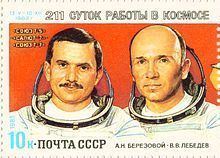COSPAR ID 1982-042A Manufacturer NPO Energia Period 1.5 hours Dates 13 May 1982 – 27 Aug 1982 Landing date 27 August 1982 | Crew size 2 up3 down Apogee 231,000 m Launch date 13 May 1982 | |
 | ||
Mission duration 16 days, 5 hours, 6 minutes, 11 seconds Launch mass 6,850 kilograms (15,100 lb) | ||
Soyuz T-5 was a manned spaceflight into Earth orbit to the then new Salyut 7 space station in 1982. While the Soyuz-T was docked it received visits from the unmanned Progress 13 resupply spacecraft, and the manned Soyuz T-6 and Soyuz T-7.
Contents
The first crew hand launched an amateur radio satellite, the T-6 mission included a visiting Frenchmen, and T-7 included the first woman in space in 20 years. It was the first mission to Salyut 7, but more than one spacecraft could be docked to S7 at a time, which is why the later missions could overlap with Soyuz T-5. The spacecraft launched with two people ("Elbrus crew"), and returned with three ("Dnieper crew").
Mission parameters
Mission highlights
This was the first (1st) expedition to the new Salyut 7 space station, launched into Earth orbit earlier in 1982. Salyut 7 was similar to the Salyut 6 (1977–1982) space station it superseded, but featured a number of improvements. The Soyuz T-5 spacecraft docked with Salyut 7 in orbit, and it was visited by the 2nd and 3rd expeditions to the space station. One advantage the new Salyut 7 station had over Salyut 6, was continuously available hot water.
The Elbrus crew ejected a 28-kg amateur radio satellite from a Salyut 7 trash airlock on May 17, 1982. The Soviets called this the first launch of a communications satellite from a manned space vehicle. They did this ahead of the launch of two large geostationary satellites from the U.S. Space Shuttle (STS-5, November 11–16, 1982).
On May 25, the Elbrus crew reoriented Salyut 7 so the aft end of the Progress pointed toward Earth. This placed the station in gravity-gradient stabilization. Lebedev remarked in his diary that the attitude control jets were “very noisy,” and that they sounded like “hitting a barrel with a sledgehammer.” Of Salyut 7 during the unpacking of Progress 13, Lebedev said, “It looks like we’re getting ready to move or have just moved to a new apartment.” The following day the Elbrus crew closed the hatch from the work compartment into the intermediate compartment so the TsUP could pump fuel from Progress 13 to Salyut 7. The crew monitored the operation but played little active role in it. May 29 was spent organizing the supplies delivered. At the same time, according to Lebedev, “we filled the resupply ship with what we don’t need and tied them down with ropes. When I enter the resupply ship, it jingles with a metallic sound, so when we separate it will sound like a brass band.” Progress 13 pumped 300 liters of water aboard on May 31. On June 2 Progress 13 lowered the station’s orbit to 300 km to receive Soyuz T-6.
End of T-5
The Soyuz T-5 spacecraft was undocked in August 1982, leaving Salyut 7 and Soyuz T-7 spacecraft in orbit. The spacecraft returned to Earth successfully with Popov, Serebrov and Savitskaya, also called the "Dneiper crew". The Soyuz T-5 had been in space six weeks.
The initial "Elbrus crew", would return to Earth in the Soyuz T-7 spacecraft in December 1982.
